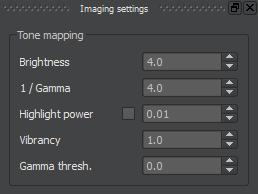Located on the right side of the main window, starting with brightness and ending with background color. Changing imaging settings does not restart your render, so you can experiment with them as your render progresses. These settings are saved with your parameters in .chaos files.

-
Brightness: For the most part, higher numbers brighten your fractal. Sometimes, when a dark IFS is on a light background, a higher brightness value seems to darken the fractal, but this is because the IFS becomes more "solid" compared to the background.
-
1 / Gamma: Affects the contrast, with lower values generally inducing more contrast. Higher values lessen (and can effectively negate) the effect of sample density/"strength" on the final pixel color, thus returning "raw" colors from the palette. This can lead to a "flattened" look, but can also be used artistically.
-
Highlight power: Changes the behavior of extremely bright and dense parts of the fractal. At a higher highlight power, they will turn white more easily, as opposed to becoming a very saturated version of the palette color.
-
Vibrancy: Something of a relic of the Flam3/Apophysis imaging. The vast majority of renders are made with the default vibrancy of 1. Lower vibrancy will wash the fractal out toward white and higher vibrancy will darken it toward black.
-
Gamma threshold: A cut-off for how dense a part of the IFS needs to be in order to be displayed in the render. By using the gamma threshold to hide the thin parts of a fractal, you can cut down on the grain that usually shows in areas with few samples.
- Background color: Chaotica does not use the standard 0-255 for this. Rather, setting all values to one will produce a white background. It is also possible to have negative values and values greater than 1.
Response Curves

Chaotica has five response curves which can be used to drastically alter the colors of a render. The overall curve essentially acts as a pre-gain, affecting all three color channels. The single-channel curves are applied after this overall adjustment. Finally, the alpha channel is independent of these, instead adjusting the transparency of the fractal against the background.
On these curves, the x-axis represents the input and the y-axis represents the output, as is standard in most image-editing software. Raising the right node will brighten the highlights and lowering the left node will darken the lowlights, creating contrast. To zoom in or out on a curve, hold alt, right click the curve area, and drag. New nodes can be added by clicking on the curve and dragging.









